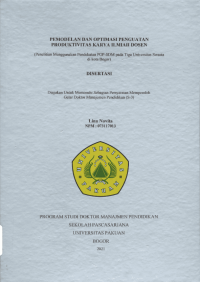Disertasi MP
Pemodelan dan Optimasi Penguatan Produktivitas karya Ilmiah Dosen: penelitian menggunakan pendekatan SOP-SDM pada tiga Universitas Swasta di Kota Bogor (Modeling and Optimization Scientific Products Quality Using POP-SDM Method)
Productivity of Lecturer Scientific Work is an important element related to the level of career achievement of lecturers and university rankings. However, the results of an initial survey conducted at three private universities in Bogor show that most of the lecturers' scientific work productivity is still low or not as expected. This study tries to reveal what factors or variables have a positive and dominant influence on increasing the productivity of Lecturers' scientific work. The population in this study are lecturers who have functional positions as expert assistants, lectors, and head lectorsfrom the three largest private universities in Bogor, amounting to 920 people and the research sample totaling 197 people. The research approach used is the POP-HR approach, namely Organizational Resource Modeling and Optimization. POP-SDM combines qualitative research to find the constellation of influences between variables, statistical mathematical models of increasing the productivity of lecturers' scientific
work, and setting research hypotheses and quantitative research to prove the research hypotheses generated in the qualitative research. The research method used is path analysis to determine the effect between the variables studied and Sitorem analysis for indicator analysis. The results showed that the resulting model for increasing the productivity ofscientific work as follows =0.296:0--1-- 0.469:a + + 0.209xJ DO Cl O O O 0.399x4 -"- with Empowerment, Academic Culture, Knowledge Management, Professional Commitment. While the optimal solution found is that there are 12 indicators that are in good condition and just need
o be maintained or developed, namely Giving responsibility according to expertise, Authority in decision making, Consistency in carrying out tasks on the basis of expertise, Individual and social responsibility, Believed academic spirit, Value -values applied to academic activities, assessment traditions, Knowledge application (practical instructions on how to apply knowledge), Knowledge
issemination (dissemination of information about the successful application of knowledge), Knowledge evaluating (evaluating the usefulness and relevance of knowledge), Intellectual Property Rights (HK!), and appreciation and a number of 13 indicators that are still weak and need to be strengthened in order of priority: /st Knowledge acquisition (acquisition of knowledge from knowledge sources), 2nd Knowledge Storing (storage and documentation of knowledge files), 3rd Seriousness in m carry out responsibilities, 4th Dedication and dedication to the institution, 5th Desire for scientific improvement, 6th Skill or expertise development, 7th Open communication between employees and leaders, 8th Flexibility in completing tasks, 9th Creativity and innovation in responding to change, l Support and cooperation of all academic community, l l th Publication, 12th Patent, and 13th Scientific Book.
Ketersediaan
Informasi Detail
- Judul Seri
-
-
- No. Panggil
-
18/NOV/D-MP/2021
- Penerbit
- Bogor : SPs. Universitas Pakuan., 2021
- Deskripsi Fisik
-
vi, 312 hlm. : ilus. ; 28 cm.
- Bahasa
-
Indonesia
- ISBN/ISSN
-
-
- Klasifikasi
-
18/NOV/D-MP/2021
- Tipe Isi
-
-
- Tipe Media
-
-
- Tipe Pembawa
-
-
- Edisi
-
-
- Subjek
- Info Detail Spesifik
-
-
- Pernyataan Tanggungjawab
-
Prof. Dr. Ing. H. Soewarto Hardhienata dan Dr..Sri Setyaningsih, M.Si.Pd.
Versi lain/terkait
Tidak tersedia versi lain
Lampiran Berkas
Komentar
Anda harus masuk sebelum memberikan komentar

 Karya Umum
Karya Umum  Filsafat
Filsafat  Agama
Agama  Ilmu-ilmu Sosial
Ilmu-ilmu Sosial  Bahasa
Bahasa  Ilmu-ilmu Murni
Ilmu-ilmu Murni  Ilmu-ilmu Terapan
Ilmu-ilmu Terapan  Kesenian, Hiburan, dan Olahraga
Kesenian, Hiburan, dan Olahraga  Kesusastraan
Kesusastraan  Geografi dan Sejarah
Geografi dan Sejarah